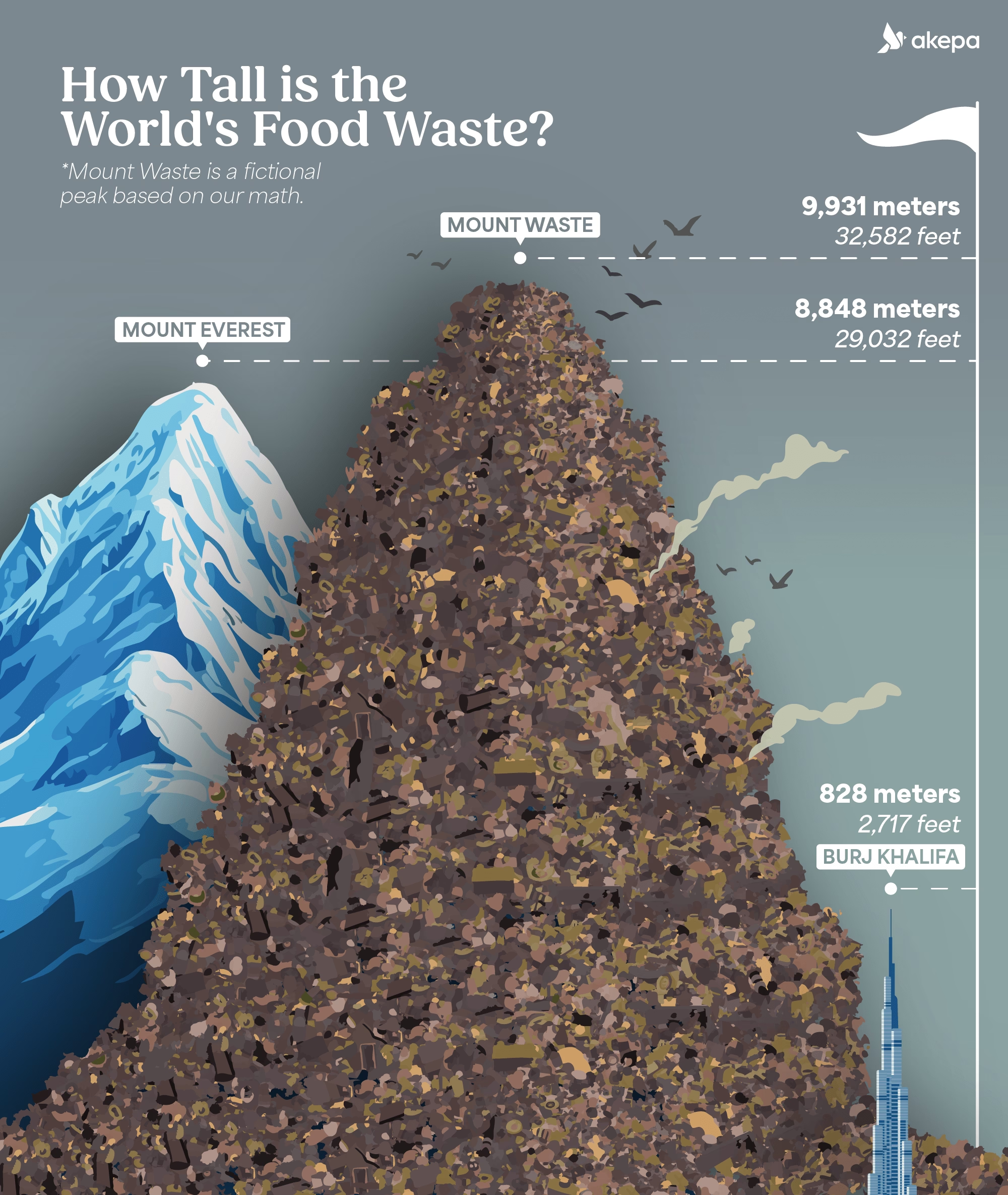We say we need to talk about a lot of things that we don’t really need to talk about. But we do need to talk about food waste.
It’s one of the biggest crises facing the world today and yet it flies under the radar, covered in flies. From mouldy strawberries in fridges to the massive mound of industrial waste, we have a problem on a global scale. And, like any bad problem, it’s escalating.
We’d normally start with a fact to support such strong statements but this post is going to do that with a bucketload of stats – and even a ridiculous calculation that transforms our planet’s waste into a mountain. So, without further ado, let’s head towards those stats yonder. We’ve split them into five areas – and you can click to be transported to the waste-zone of your choice.
Ingredients (click to skip to the section):
- Facts on the scale of the problem
- Facts on the impact on the environment
- Facts on the impact on the economy
- Facts on the impact on society
- Facts on where the waste happens
But first, before the gloomy figures, enjoy this bright preliminary slideshow on a key factor behind food being rejected from supermarkets: wonkiness
🏔 The Scale of The Problem
Let’s put things in perspective by examining the monolithic size of the food waste mountain.
1. Globally, it’s estimated that at least 1.3billion tonnes of food gets wasted each year (Wrap, 2025).
2. This oft-cited stat was first published in 2011, in a report from the FAO called Global Food Losses & Food Waste, so is likely now much higher (FAO, 2011).
3. Incredibly, and depressingly, that’s roughly a third of the entire world’s food.
4. In the EU, where around 5.5% of the global population lives, around 58 million tonnes of food are waste every single year – with 31 million tonnes coming from households. If you extrapolate that stat it roughly accords with the 1.3 billion stat from 2011. (Eurostat, 2025).
5. If we assume a 1km width, and 500m radius, this 1.3 billion tonne mountain of waste would be the highest mountain on Earth at 32,582 feet. The second highest after Mt. Waste would be Mt. Everest at 29,030 feet (Akepa, 2025 – see methodology at the end of the post).

🌎 The Environmental Toll
The waste of food is one of the main drivers behind climate change. Food production consumes vast amounts of land, water, and energy only to end up rotting in landfills – releasing the potent greenhouse gases that cause our planet to heat.
6. Food production overall, has a large environmental impact and generates around 26% of global GHG emissions [Our World in Data, 2025].
7. Meanwhile, food loss and waste is estimated to generate 8-10 per cent of annual global greenhouse gas emissions [UN, 2025].
8. These emissions are slightly higher than those of the entire fashion industry and almost five times the total emissions generated by the aviation sector [EU, 2024].
9. Approximately 30% of the world’s agricultural land is used to grow food that ultimately ends up being wasted [Winnow, 2024].
10. In the European Union, the food production that resulted in EU waste in 2022 consumed 342 billion cubic meters of water [European Parliament Think Tank, 2025].
11. The disposal of food loss and waste in landfills, which leads to methane gas emissions, which are around 80x more potent than CO2 [Environmental Science & Policy, 2022].
💰 The Economic Drain
Food waste isn’t just about the planet. Wasting food represents a grave financial loss across the entire supply chain, costing people, businesses, and governments nearly a trillion dollars annually. That’s money that could be put to good use otherwise.
12. The combined toll of food loss and waste on the global economy is estimated to be upwards of $940 Billion per year [UN Environment Programme, 2024].
13. For the EU, the market value of food waste generated annually is estimated at 132 billion euros [European Commission, 2023].
14. People in the US spent $261 billion on food they didn’t ultimately eat in 2023 [ReFed, 2025].
15. The annual cost of edible household food waste in the UK was over £17 billion in 2022 [Numan, 2025].
16. In the US, the total value of surplus food generated in 2023 reached $382 Billion [ReFed, 2025].
🫂 The Social Injustice
We shouldn’t forge that he food waste crisis is, at root, a humanitarian failure. It’s a mountain built on moral contradictions where vast amounts of food are discarded while millions face hunger.
17. Households worldwide waste the equivalent of at least one billion meals every single day [UNEP, 2024].
18. In 2024, nearly 300 million people were affected by hunger worldwide [Global Hunger Index, 2024].
19. Globally, the prevalence of moderate or severe food insecurity stood at 28.0 percent in 2024 [FAO, 2025].
20. Japan achieved a 31% reduction in total food waste (per capita at household, food service, and retail levels) between 2008 and 2020, demonstrating that large-scale change is possible [UNEP, 2024].
21. The EU has set a legally binding target to reduce food waste by 30% per capita across retail, catering, food services, and households by the end of 2030 [European Parliament, 2025].
📈 Where the Waste Happens
Food loss refers to waste that occurs before retail, typically due to infrastructure or logistical issues. Food waste is waste that occurs at the retail and consumer level. The latest data reveals the key culprits and baddies.
22. Globally, approximately 13.2 percent of all food produced is lost between harvest and retail (production/processing) [FAO, 2025].
23. A further 19 percent of total global food production is wasted in households, food service, and retail [UNCC, 2024].
24. In 2022, households were the single largest source of food waste globally, contributing 631 million tonnes, or approximately 60 per cent of the world’s total food waste [UNEP, 2024].
25. The food service sector (restaurants, cafeterias, etc.) generated the next largest share, accounting for 28 per cent (290 million tonnes) of the total in 2022 [UNEP, 2024].
26. The retail sector (supermarkets, stores) contributed the remaining 12 per cent of consumer-level food waste in 2022 [UNEP, 2024].
27. In the US food system, the largest amount of waste by tonnage comes from the residential sector (35.2%), followed by the farm (23.8%) and manufacturing (17.8%) sectors [ReFed, 2025].
28. Produce represents the largest food category that is wasted in the US, followed by prepared foods [ReFed, 2025].
🧮 How to calculate Mt. Waste?
Our rough-and-ready methodology
To turn this massive weight into a realistic height, we must take some liberties. Think of this as a cheeky, back-of-the-envelope calculation, not a precise engineering feat or authoritative research paper.
- Shape: We’re picturing a classic mountain shape – a cone.
- Density: Food waste isn’t like rock! It’s lighter and less compact. For our purposes, we’ll use an average density of 500kg per cubic meter (about half the density of water). This is a common estimate for uncompacted household food waste.
- The Scenario: We’re imagining a particularly constrained base for our food waste mountain: 1km wide (or about 0.62 miles).
Crunching the numbers
- First, let’s convert our 1.3 billion tonnes into kilograms: 1.3 billion tonnes = 1.3 x109
- 1.3 x 109 tonnes x 1000kg/tonne = 1.3 x1012kg
Next, we calculate the total volume this mass would occupy given our typical density:
- Volume (V) = Mass / Density
- V = 1.3x 1012kg / 500kg/m3 = 2.6x 109m3 (or 2.6 billion cubic meters)
Now, for the tantalising part – the height. Mt. Waste has a base diameter of 1km, meaning a radius of 500m. Using the well-known formula for the volume of a cone (V=1/3πr2h), we can rearrange it to find the height (h):
The Verdict: Taller than Everest (or an elevensome of Burj Khalifas)
So, how far into the sky would Mt. Waste extend? A staggering 9,931 meters, which translates to approximately 32,582 feet.
To put that height into perspective:
- That’s taller than Mount Everest (8,848 meters or 29,032 feet).
Or for those who prefer skyscrapers…
- It’s like stacking over eleven Burj Khalifas (the world’s tallest building, 828 meters) on top of each other!
Now, it is admittedly true that further calculations reveal that such a tall mass, of this width, would be unstable – to say the least. However, surely some promethean genius like Elon Musk or Sam Altman would step in with some fancy tech to help us get Mount Waste as lanky as possible.
🥪 The next time you munch or bite…
Remember. The facts above make it clear that food waste is becoming a very messy problem. Looking ahead, policy changes, increased awareness and clever innovations will make an impact but Mt. Waste hasn’t reached its peak yet and is steadily rising. If it’s not dealt with, more of us could start suffering under its shadow.
We’ll make sure to update this article with the latest studies, stats, and research. Feel free to use these to reinforce your story – wherever you’re telling it. And remember, facts alone aren’t enough to shape a convincing narrative. If you’re looking for a hand telling the world about your mission, why not say hello? We’ve supported businesses of all sizes to tell their stories.
Hungry for even more stats? We’ve also prepared this post on facts and stats about sustainability.









Leave a Reply